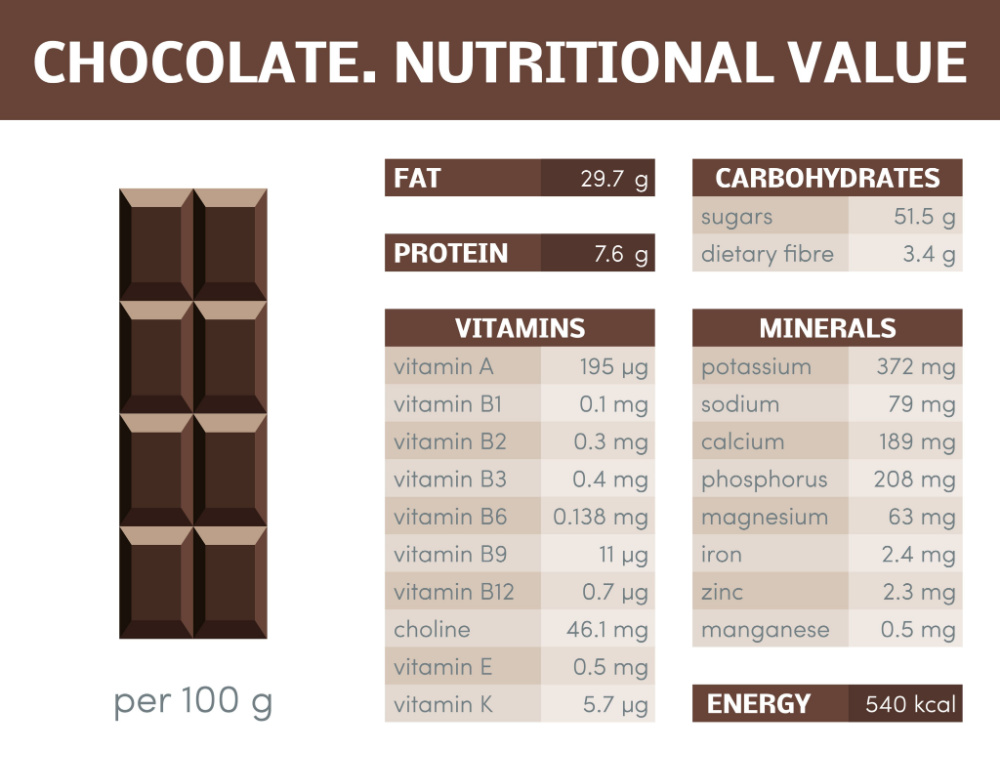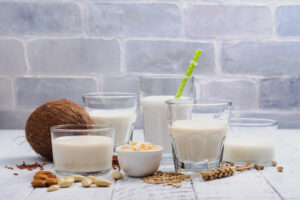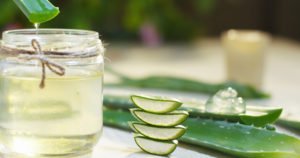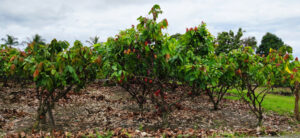Dark chocolate is a staple in my house, but I’m not really allergic to milk. I sometimes sneeze if I drink too much, but that’s about it. I never react to dark chocolate. But some of you do, and you already know to avoid milk chocolate. But what are you supposed to do if you’re allergic to milk, and want dark chocolate?
It’s a good question, especially because there have been many reports that consumers had harmful allergic reactions after enjoying a snack bar or other food that contained dark chocolate.
Milk is actually allowed as an ingredient in “dark” chocolate, but milk is one of the 8 primary food allergens that has to be disclosed on the label. Well, it’s supposed to be anyway, but you can’t trust the food industry to disclose every last thing, especially if it doesn’t cross the threshold of having to be listed on the nutrition facts panel.
But so you know, our federal laws require manufacturers to label their food products and list all the major allergens, including milk. Did you know that undeclared milk is the most frequent cause of a food recall. Chocolates that contain milk (undisclosed) are among the most common cause of an allergic reaction.

It’s not just me saying this. The FDA actually tested 94 different brands of dark chocolate bars, and they specifically tested it for the presence of milk. Of these 94 bars, only 6 of them listed the ingredient of milk! 😮 The other 88 bars did not disclose milk as an ingredient, yet 51 of them contained milk!
Is it that the chocolate bar makers want you to buy their brand and have a bad reaction? No, of course not, they want you to come back as their customer, they’re not trying to give you anaphylaxis!
It’s unfortunate but true that milk can get into a dark chocolate product even when it’s not added. As an aside, milk protein is sometimes used in the refining process of wine which could trigger an allergic response in a very sensitive individual. But today’s article is about chocolate.
The problem happens because the dark chocolate is often produced on the same equipment that makes their milk chocolate bars. And traces of milk often inadvertently wind up in the dark chocolate batter. It’s essentially a problem of cross-contamination. My best suggestion to you is to completely avoid dark chocolate (if you’re allergic to milk/dairy) unless the brand you’re buying is made on equipment dedicated to dark chocolate bars only. This is hard to find, but possible.
This is why it’s difficult to place your trust in the food industry. They don’t mean to make people sick, but their laziness or sloppiness can lead to pain and suffering for some of you. As a result, you see warnings on the label that serve as a wink of sorts. This product “may contain dairy” or “may contain traces of milk” or this one, “manufactured in a facility that uses milk.” There are others but if you’re my best friend, I would tell you to replace the word “may” with “probably!”

If you’re extremely sensitive to certain foods, the best advice is to stay away, no matter what health benefits they may contain. This is what my poor husband Sam learned about mangoes! CLICK HERE to read my article about this delicious fruit – Mangoes are Magnificent Unless You Are Allergic.
That FDA study I mentioned a minute ago also found that milk proteins were present in 75% of every dark chocolate bar they tested, and they had a cautionary statement. The interesting part is that some dark chocolates had almost as much milk in them as pure milk chocolate!
This thickens the plot for vegans who don’t want to consume milk, but are likely doing so if they consume dark chocolate that “may contain dairy” or has been “made on equipment shared with milk.” Twenty-five percent of chocolate bars tested (marked as “vegan”) contained milk, which is really high!
The take home message is you should not assume that your dark chocolate is free of milk, and you should not consume it if you have serious allergic reactions to milk, regardless of the label. Besides avoidance, did you know there are other things you can do to soothe allergies? CLICK HERE to read my article 10 Natural Solutions for Allergies and Sinusitus.
You also might want to think about taking aloe vera, which has been shown to help mitigate the harm caused by food allergens. CHECK OUT my article Aloe Vera Has 11 Impressive Uses.

Below, I’ve written a little checklist to help you if you’re extremely sensitive to milk or dairy proteins/sugars such as casein or lactose.
Caution and Advice
- Dark chocolate is high risk for people with milk allergies because the ingredient list may not disclose “milk” since it gets into the product via contamination.
- If you’re highly allergic to milk (ie casein or lactose or any other component) avoid dark chocolate. You can always call the company and ask them for a Certificate of Analysis to prove their brand is FREE of milk proteins. They may or may not give you this, but if they’re truly reputable, it should be something they will share. It’s a one-page document.
- Don’t believe the ingredient list. Milk may not be listed (it probably is NOT) even listed.
- Read all the statements on the label to see if it says “may contain milk” or any other cautionary statement that clues you in to the fact that it might contain undisclosed dairy.
- Don’t get confused. It may very well say “vegan” or “dairy free” on the label, but this does not necessarily mean it is truly vegan. The reason is that the food maker may NOT have added milk, but it may still be present if the dark chocolate bar was made on the same equipment as some other food that contained milk. They’re allowed to say “vegan” and/or “dairy free” if they don’t add milk to the formula, but that doesn’t mean that it’s really milk free.
- Dairy free claims and statements on the label should be completely disregarded IF the manufacturer fails to use dedicated machinery and equipment due to cross contamination.
- Lactose free chocolates are not necessarily free of milk. Lactose is a milk-derived sugar, and this portion may have been extracted, but the milk proteins such as casein may very well still be there, and probably are! In other words, the removal of lactose does not make anything milk or dairy free.
Allergen contamination is rampant in the food and dietary supplement world. They need to, and want to sell as much product as possible. The hazards of food allergens, artificial ingredients and dyes are all out there, in plain view for all of us to see. Sometimes we just don’t want to see it. I’m a huge chocolate lover 🤗, and I can’t imagine my life without this sweet indulgence, but if you’re extremely allergic to milk, I want to keep you safe and that’s the purpose of today’s article. If you have any questions about the particular brand you eat, call the manufacturer directly.
Here are some aliases which should be interpreted as milk, or derived from milk:
-
- Cream
- Milk fat
- Sodium caseinate (the chemical name for casein which is the primary protein in milk)
- Calcium caseinate or any “caseinate,” including but not limited to aluminum caseinate, magnesium caseinate or potassium caseinate. (These are aliases of casein.)
- Whey or whey protein or whey protein concentrate. Whey may be of particular concern to vegans who sometimes miss “whey” on the label. Not only is whey related to milk, but there are some chocolate brands that utilize whey protein and depending on the brand they source, whey powder may contain rennet, which is a very commonly used coagulating enzyme taken from a calf’s stomach.
- Curds
- Hydrolyzed casein
- Lactalbumin
- Lactate
- Lactoferrin
- Lactoglobulin
- Lactose
- Sour cream
- Rennet
There’s more reading to do at the FDA website if you feel led to investigate this more. I have two links for you:
Dark Chocolate and Milk Allergies
A Survey of Milk in Dark Chocolate Products

As a final note about chocolate, you might find these fun facts of interest:
- Chocolate comes from roasted and ground cacao seeds.
- The seeds of the cacao tree are very bitter, just try pure dark chocolate and you’ll see what I mean. In order to taste good to your palette, they must first be fermented, then the beans are cleaned, dried and roasted. The shell is removed to produce what’s called cocoa nibs (you can buy this all by itself), and then it’s all ground up to a big cocoa mass. It’s heated and this portion is called chocolate liquor, but there’s no added alcohol.
- White chocolate doesn’t contain ANY cacao whatsoever, it’s just a combination of cocoa butter, sugar, and milk, but no cocoa solids.
- Americans love chocolate, but most of the world’s cacao farms are in not even located in the U.S. In fact, the world’s biggest farms are located outside the US, and here are some of them, in no particular order: Ghana, Indonesia, Cote d’Ivoire, Cameroon (both in Africa), Peru, Dominican Republic, Nigeria, Equador, Mexico and Brazil.

Suzy Cohen, has been a licensed pharmacist for over 30 years and believes the best approach to chronic illness is a combination of natural medicine and conventional. She founded her own dietary supplement company specializing in custom-formulas, some of which have patents. With a special focus on functional medicine, thyroid health and drug nutrient depletion, Suzy is the author of several related books including Thyroid Healthy, Drug Muggers, Diabetes Without Drugs, and a nationally syndicated column.


